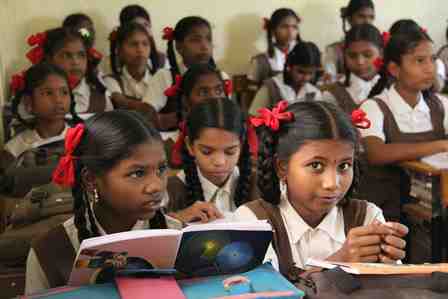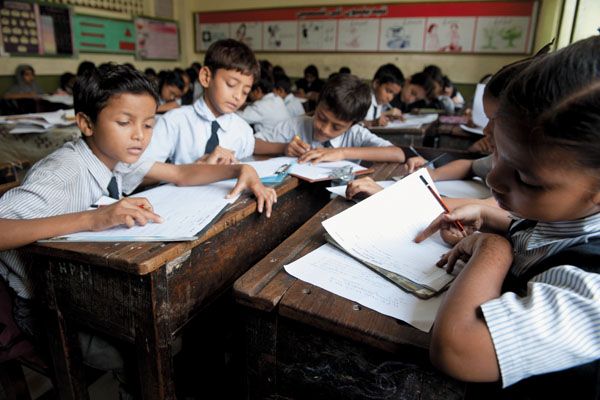A fact finding report reveals links between the level of women’s education in India and their subsequent status in life.
by Child Relief and You (CRY)
In India, all issues related to girl children ranging from female infanticide, domestic child labour to prevention of girl child trafficking are all enormously challenging tasks requiring sustained efforts on part of all duty bearers. Like all other rights viz Right to Nutrition, Development, Protection and Participation, a girl’s Right to Education continues to remain a critical and seemingly insurmountable challenge.
Last few years have seen a significant improvement in school enrollment at primary education, however, the same is not the case with secondary and higher secondary level. The Net Enrollment, which is a measure of the percentage of girls who attend school age-appropriately, is 89% at the primary level, and it drops to a meager 32% in higher secondary education (Source: Unified-District Information System on Education (U-DISE) 2014-15).
The link between low education and early marriage
Today India is leading in the total number of child brides globally. There is abundant documented evidence linking lack of education to early marriage, particularly for girls. There are also available studies showing the link between low education level of mothers and the early marriage of their daughters. NFHS-3 (2005-06) revealed that more than 85% of the surveyed girls who were married before the age of 18 had mothers who had received less than 10 years or no education.
We also have a high number of girls working as domestic workers and those who constantly face issues of protection. At a micro level the work demands convincing parents of the girl child to continue her schooling; changing attitude and practices of communities and closely tracking that no girl child drops from school. The need of the hour is to invest adequately in secondary and higher secondary education for this segment of population, so that our girls stay away from these multiple vulnerabilities.
The figures on the ground
The RTE Act (2009) covers children between the ages of 6 to 14 years, and enables free and compulsory education at the primary and upper primary levels. However, in absence of any legislation for children above the age of 14 years the scenario at the secondary and higher secondary level unfortunately remains dismal. The average annual dropout rate for girls rises from 4.14% at primary level to 17.8% at secondary level (Source: U-DISE 2013-14). Access to education post the elementary level continues to be a huge challenge, considering only 15.4% of schools in India offer secondary education and further still only about 7% of the schools offer higher secondary education.
| Year | % of Privately Owned Secondary Schools | % of Privately owned Higher Secondary Schools |
| 2010-11 | 54.8% | |
| 2011-12 | Data not available | |
| 2012-13 | 52.38 | 54.04 |
| 2013-14 | 54.76 | 55.57 |
| 2014-15 | 55.52 | 58.79 |
| Table-1 showing share of privately owned[1] schools in India (U-DISE statistics) | ||
Back in 1966, the education commission (1964-66) chaired by DS Kothari recommended that India should allocate 6% of its GDP. Later this figure was challenged and revised by many scholars but the fact still remains that India is nowhere close this figure in terms of spending on education. More than 55% of schools offering secondary and higher secondary education in the country are not State-owned which renders them unaffordable to children of low income households (Source: U-DISE 2014-15). On the other hand the share of State owned schools have not seen any significant increase over the years.
| STATE | % OF PRIVATE SECONDARY SCHOOLS | % OF PRIVATE HIGHER SECONDARY SCHOOLS |
| Maharashtra | 92 | 94.8 |
| Uttar Pradesh | 90.44 | 94.1 |
| Gujarat | 86.65 | 91.78 |
| Karnataka | 64.94 | 68.32 |
| Kerala | 67.92 | 64.72 |
| Table -2-Top 5 states having private ownership of secondary and higher secondary schools (U-DISE 2014-15) | ||
Only in 10 out of 36 States in the country does the Government currently have an ownership share of two thirds or more of both secondary and senior secondary schools. The issue of privately-owned schools needs further attention in States such as Maharashtra and Uttar Pradesh where the percentage of private schools is more than 90% at the secondary and higher secondary level.
According to the 12th Five Year Plan (FYP), household expenditure for children going to private schools is higher (Rs. 893/- per month) than for Government schools (Rs. 275/- per month). The lack of access to secondary and higher education coupled with this challenge of affordability certainly impacts the girl child most since traditionally, families are more likely to invest in the education of the male child and girls tend to be married off early. There are over 4.6 million married children in India the age group of 15-17 years (eligible for secondary and higher secondary education), of which more than 70% (3.35 million) are girls.
Kreeanne Rabadi, Regional Director, CRY – Child Rights and You adds, “Mindsets to educate girl child are changing in India. Even in the most remote villages, many parents want to send their daughter to school. We need to drastically increase resources to meet these demands of making secondary and higher level education, affordable and easily accessible to girl child.”
(Picture courtesy www.realyouth.org. Image is used for representational purpose only)

